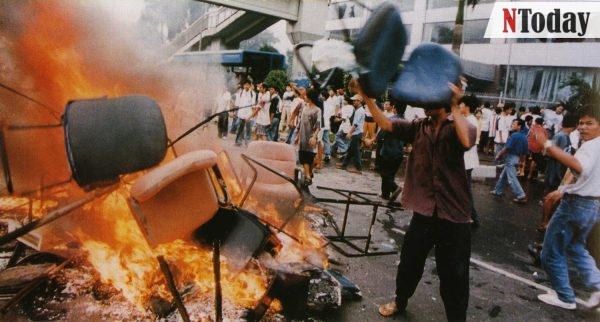The year 1998 marked a tumultuous period in the history of Indonesia, characterized by widespread unrest, violence, and political upheaval. The economic crisis that swept through the region, coupled with longstanding grievances against the authoritarian regime of President Suharto, culminated in a series of riots and protests that rocked the nation and ultimately led to the downfall of Suharto’s regime. In this comprehensive exploration, we will delve into the history of the 1998 riots in Indonesia, examining their causes, key events, and lasting impact on the country’s political landscape and society.
Part 1: Economic Crisis and Social Discontent
1.1 Background: The roots of the 1998 riots can be traced back to the economic crisis that engulfed Southeast Asia in the late 1990s, commonly known as the Asian Financial Crisis. Indonesia, as one of the hardest-hit countries in the region, experienced a sharp decline in economic growth, a collapse of the currency (the Indonesian rupiah), and a surge in unemployment and poverty. The economic downturn exposed structural weaknesses in Indonesia’s economy, including crony capitalism, corruption, and excessive government intervention, fueling public discontent and anger towards the ruling regime.
1.2 Social and Political Conditions: Against the backdrop of economic turmoil, Indonesia was also grappling with deep-seated social and political tensions that had been simmering beneath the surface for decades. President Suharto, who had ruled the country with an iron fist for over three decades, faced mounting criticism and opposition from various segments of society, including students, activists, intellectuals, and religious groups. Calls for political reform, democratization, and an end to Suharto’s authoritarian rule grew louder, as Indonesians sought greater freedoms, accountability, and representation in their government.
Part 2: Triggering Events and Outbreak of Violence
2.1 IMF Bailout and Austerity Measures: In response to the economic crisis, the Indonesian government sought assistance from the International Monetary Fund (IMF) and other international financial institutions, agreeing to implement a series of austerity measures and structural reforms in exchange for financial support. These measures, which included cuts to subsidies, deregulation, and privatization of state-owned enterprises, exacerbated social inequalities and deepened the economic hardships faced by ordinary Indonesians, particularly the urban poor and marginalized communities.
2.2 Ethnic and Religious Tensions: The economic crisis also exacerbated existing ethnic and religious tensions in Indonesia, leading to outbreaks of violence and communal conflicts in various parts of the country. Ethnic Chinese Indonesians, who were disproportionately affected by the economic downturn due to their perceived wealth and status, became targets of resentment and scapegoating, resulting in looting, arson, and attacks on Chinese-owned businesses and properties. Additionally, religious minorities, particularly Christians, faced discrimination and persecution in the predominantly Muslim country, further exacerbating social divisions and grievances.
Part 3: Spreading Unrest and Government Crackdown
3.1 Student Protests and Civil Unrest: As the economic and social crisis deepened, student-led protests erupted across Indonesia, demanding political reform, an end to corruption, and the resignation of President Suharto. The protests, which began in universities and campuses, quickly spread to the streets of major cities, drawing support from a wide cross-section of society. The demonstrators, buoyed by a sense of solidarity and defiance, engaged in acts of civil disobedience, street demonstrations, and sit-ins, challenging the authority of the government and calling for meaningful change.
3.2 Government Repression and Violence: In response to the growing unrest, the Indonesian government unleashed a brutal crackdown on protesters, deploying security forces, including the military and police, to quell the demonstrations by any means necessary. The crackdown resulted in widespread violence, with security forces using tear gas, batons, and live ammunition to disperse crowds and suppress dissent. Thousands of protesters were arrested, beaten, and detained without trial, while others were subjected to torture, disappearances, and extrajudicial killings, leading to a climate of fear and intimidation across the country.
Part 4: Fall of Suharto and Transition to Democracy
4.1 Resignation of President Suharto: Amid mounting pressure and international condemnation of his regime’s human rights abuses, corruption, and economic mismanagement, President Suharto finally resigned from office on May 21, 1998, after 32 years in power. His resignation, which came in the wake of escalating protests and violence, marked the end of an era in Indonesian politics and paved the way for a transition to democracy and civilian rule.
4.2 Reformasi Movement and Democratic Transition: Following Suharto’s resignation, Indonesia entered a period of political transition and reform known as Reformasi, or Reform. The Reformasi movement, led by civil society groups, political parties, and grassroots activists, called for greater political freedoms, accountability, and transparency in government. In October 1998, Indonesia held its first democratic elections in over three decades, leading to the election of Abdurrahman Wahid as president and the establishment of a new era of slot gacor democracy and pluralism in the country.
Part 5: Legacy and Lessons Learned
5.1 Legacy of the 1998 Riots: The 1998 riots and the fall of President Suharto’s regime had a profound and lasting impact on Indonesia’s political landscape, society, and economy. The events of 1998 marked a turning point in the country’s history, ushering in a period of democratic reforms, political openness, and social change. The riots exposed the underlying fragility and injustices of Indonesia’s authoritarian system, while also demonstrating the power of grassroots movements and collective action in bringing about meaningful change.
5.2 Lessons Learned and Challenges Ahead: As Indonesia continues to grapple with the legacy of the 1998 riots and its transition to democracy, the country faces a range of challenges, including political corruption, social inequality, and religious extremism. The events of 1998 serve as a reminder of the importance of upholding democratic principles, protecting human rights, and fostering inclusive governance to ensure a more just, prosperous, and peaceful future for all Indonesians.
Conclusion:
The 1998 riots in Indonesia were a watershed moment in the country’s history, marking the end of President Suharto’s authoritarian rule and the beginning of a new era of democracy, reform, and social change. The riots, fueled by economic hardship, political repression, and social discontent, laid bare the underlying tensions and injustices in Indonesian society, while also galvanizing a movement for political reform and democratic renewal. As Indonesia continues its journey towards a more democratic and inclusive future, the lessons of 1998 remain relevant and instructive, reminding us of the power of collective action, resilience, and hope in the face of adversity.

















